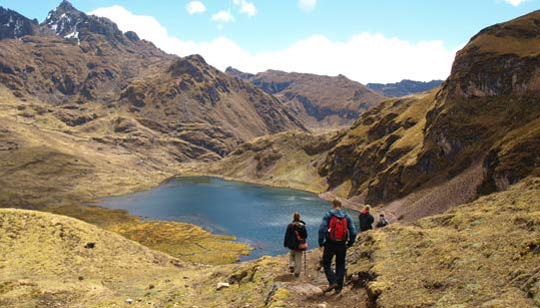

Billowing green hillsides played hide and seek in front of me; the thrusting walls of the Patacancha Valley zigzagged up and away, each one hazier in the distance. Though cliches of mystical discovery and hidden treasures are run to death here, the Peruvian Andes do have a way of making one yearn to see what lies just beyond. Standing on the roof of my rented Ollantaytambo home, the valley beckoned.
I had arrived on that rooftop after my boyfriend and I decided to spend several months volunteering in Peru, but I didn’t yet know how much beauty lay just beyond my doorstep. The Patacancha Valley veers from the larger Sacred Valley at the town of Ollantaytambo, two hours from Cusco and little more than an hour from Machu Picchu. A dirt road climbs through the smaller valley past rural communities and ruins which predate the Inca empire.
Talking to my neighbors, I began to learn the names of these places, signposts passed down through centuries of diverse inhabitants: Bandolista, Medialuna, Choquebamba, Choquechaca, Willoq, Kelkanca. The more we asked, the more stories unfurled, and every weekend we trotted up the road out of town trying to see more.
One day, our friend Pancho invited us to visit Pallata, his hometown in the Patacancha Valley, and hike to the Pre-Incan ruins above, called Pumamarca. During the 30-minute taxi ride up the valley, he reminisced about about knowing every footpath and rocky outcrop from walking with his father, a beloved curandero, or healer.
After saying hello to family and snacking on some toasted corn, we wove our way up to the ruins. Pumamarca was supposedly built as a defensive lookout and sits perched on a grassy knoll. Cold mist blew down from the high peaks out of sight above our heads. Stone walls surrounded a complex of lichen-covered buildings, including an unusual circular structure whose function we can only wonder at. We reclined in the grass and Pancho asked what we think. “Hermosa, beautiful,” somehow wasn’t even adequate, but he smiled back.
Another day, we followed crowds and rode a bumpy combi van to Markacocha for Dia de Compadres, a festival meant to strengthen and celebrate the generations-old relationships between families of the valley who may live hours from each other. Markacocha is home to the oldest Spanish church in the area, made of mud-colored adobe and a thatched roof. After drinking a glass of chicha, local corn beer, we climbed to the ruins on a high hillside for a crows-eye view. One boy was there with his burros, and pointed out trails we could barely see on the surrounding ridges, leading to more places and more stories. It was always in these moments, just when I felt I had arrived somewhere new, that I realized I could explore this valley forever and never really know it all.
If You Go
Visiting the Patacancha Valley is surprisingly easy for travelers of all interests and abilities. Many beautiful spots can be reached on foot from Ollantaytambo, including Pumamarca, which is a popular 3-4 hour roundtrip hike. Ask around town for hiking suggestions or local guides to hire; dayhiking and backpacking opportunities abound. The road is usually passable by any car and taxis can be rented in town to visit Markacocha or other more remote communities like Willoq (40 minutes by car) and the town of Patacancha (about an hour by car), which both have projects to support traditional textile making. It is also easy to arrange guided horseback and mountain bike tours right in Ollantaytambo or in advance through a specialist in Peru adventure trips.
- How to Get Around in Sydney: A Local’s Guide to Traveling Around Sydney - April 24, 2024
- The Low-Key Magic of Ghent, Belgium - April 22, 2024
- Discover the Hidden Charm of Extremadura in Spain - April 20, 2024
